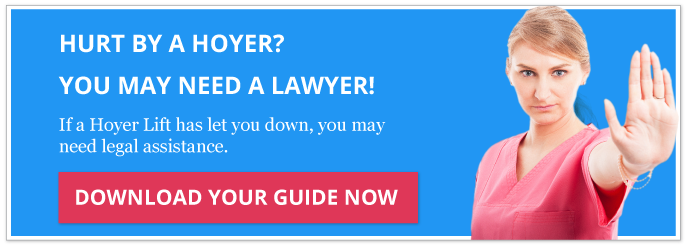Part 7 in an 8-part series
Hoyer Lifts Can Injure Home Health Care Providers
Nurses, caregivers, and other healthcare providers are suffering too many serious, preventable injuries solely due to unsafe lifting practices every year. In fact, it is such an issue that several U.S. Representatives and Senators have introduced legislation several times called the Nurse and Health Care Worker Protection Act. The goal of the legislation to try and address the hazards that workers face from having to lift patients.
Specifically, caregivers suffer from work-related musculoskeletal disorders much more frequently than any other workers. These injuries can cause a lifetime of chronic pain and force many health care workers to leave the profession early on in their careers.
There are patient safety measures that can be taken to prevent these injuries from occurring in the first place. For example, most U.S. industries that involve manual lifting follow guidelines promulgated by the National Institute for Occupational Safety and Health (NIOSH) by supplying equipment to handle any loads that are more than 50 pounds or above shoulder-height. However, caregivers must frequently lift or move an entire person while also cautiously handling any life-sustaining equipment (such as intravenous tubing), which places the caregiver at significant risk of getting injured.
Injured on the Job
Home caregivers are typically doing work that involves aiding residents who request assistance in performing daily activities. These are called in-home care services. In most of these cases, residents and patients are entirely dependent upon their caregivers for mobility. Lifting activities required of caregiver jobs are associated with an increased risk of pain and injury to the caregiver, especially to the back and shoulders.
Getting Hurt Using a Hoyer Lift
Unfortunately, various factors that caregivers deal with on a day-to-day basis places them at a higher risk of injury; factors such as:
- Heavy physical work;
- Lifting movements;
- Bending and twisting;
- Whole-body vibrations;
- Static and/or sustained work postures; and
- Repetition or frequency of movement pattern.
Additional risks come from the increasing levels of obesity among the general population, the aging caregiver workforce, staffing shortages, stress due to organizational changes, unfamiliar lifting equipment, and a lack of training with an emphasis on self-protection and patient safety during all patient handling and movement. When combined with the risk factors listed above, it is a recipe for disaster; while attempting to lift a patient from or to a bed and into our out of the sling of a Hoyer lift, caregivers can experience back injuries such as lumbar sprains, herniated discs, lower back sprains, torn rotator cuffs, and related musculoskeletal injuries.
Preventing Injuries
One of the most important steps employers of home health care providers and caregivers can take is to develop and implement a healthcare worker back injury prevention plan, in order to protect caregivers from injury. This plan would include a process for addressing ergonomics, recognizing occupational health and safety hazards, and preventing injuries that are specific to home caregivers. It should also include a written lifting and handling plan which contains, at a minimum:
- Policy and procedures regarding safe patient handling and lifting;
- A mechanism to address nurses’ refusal to perform unsafe lifting and handling; and
- What education and training programs are available to staff.
This includes a needs assessment entailing patients’ lift and transfer requirements and thus, proper equipment and training needs. For many facilities, this includes providing staff with “lift teams” who are on-call to assist with lifting and repositioning patients using equipment such as Hoyer lifts so as to prevent staff from getting injured. It also includes training and periodic evaluations as part of how to use the patient Hoyer lift program properly.
Hoyer Lift Injuries and Help from a Workers Compensation Attorney
While the impression that many caregivers receive is that mechanical equipment such as a Hoyer lift significantly reduces injury, in fact, according to some reports, 53% of technicians who use this equipment reported chronic pain and/or injuries.
At Krasno, Krasno & Onwudinjo, we have represented many caregivers in their workers’ compensation claims. Every year, the statistics covering injuries that the caregiver profession experiences is staggering and alarming. Thousands have to miss work every year due to injuries related to lifting or moving patients.
Employers purchasing Hoyer lifts as an attempt to address workers’ compensation claims simply is not enough to prevent injuries to staff. Without proper training, equipment maintenance, equipment availability, and the presence of lift teams, this equipment can lead to the same musculoskeletal injuries that manual lifting causes.
It is also crucial that home caregivers feel comfortable reporting their injuries. Pennsylvania law protects these workers who file compensation claims, but it is wise to work with an experienced workers’ compensation lawyer in pursuing a claim in order to ensure that your rights are protected throughout the process.
If you have been injured, contact one of our work injury attorneys today by calling 800.952.9640 or get in touch online.
Disclaimer: This content is considered advertising and does not constitute any client-attorney privilege and does not offer any advice or opinion on any legal matter.





